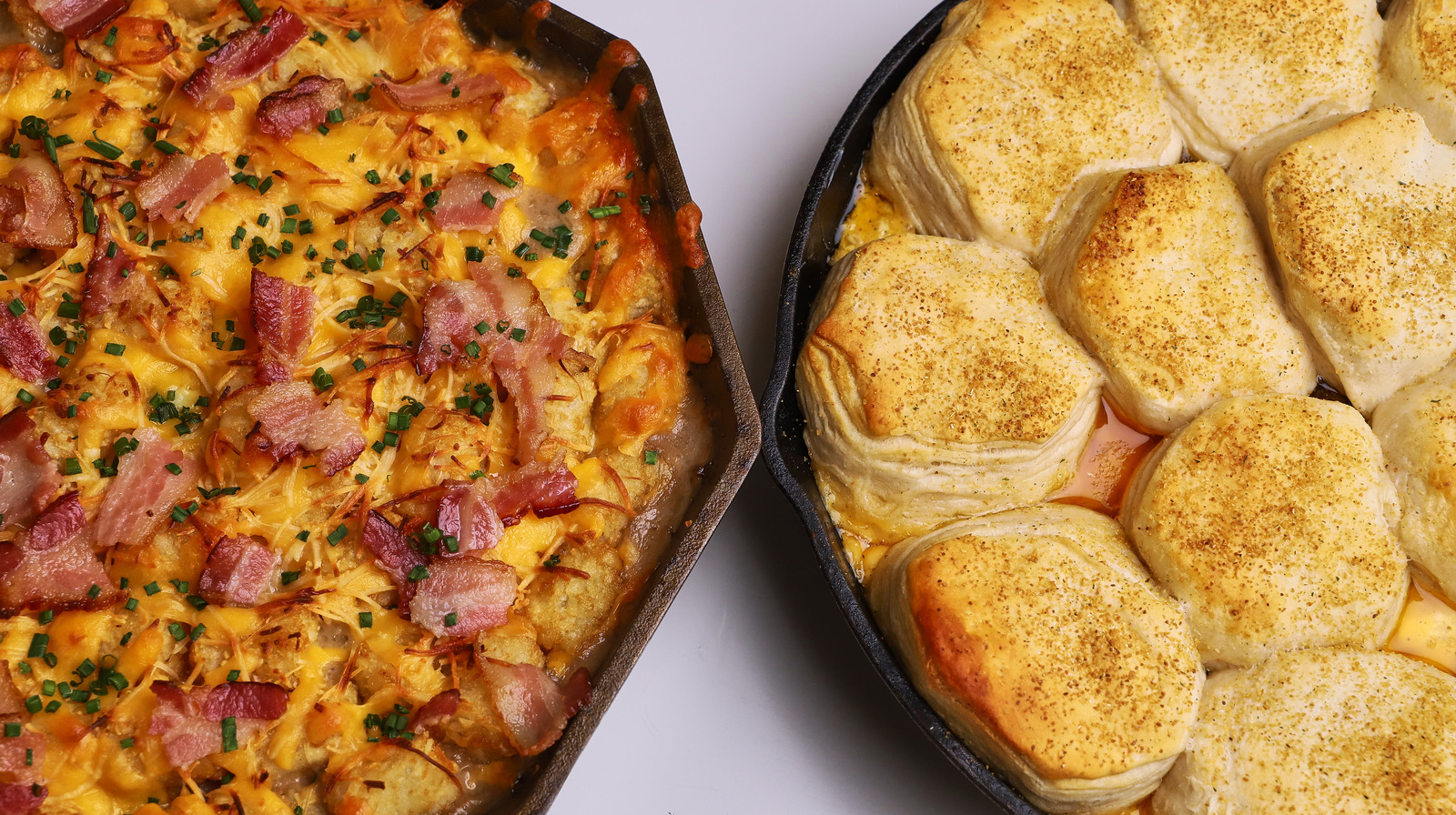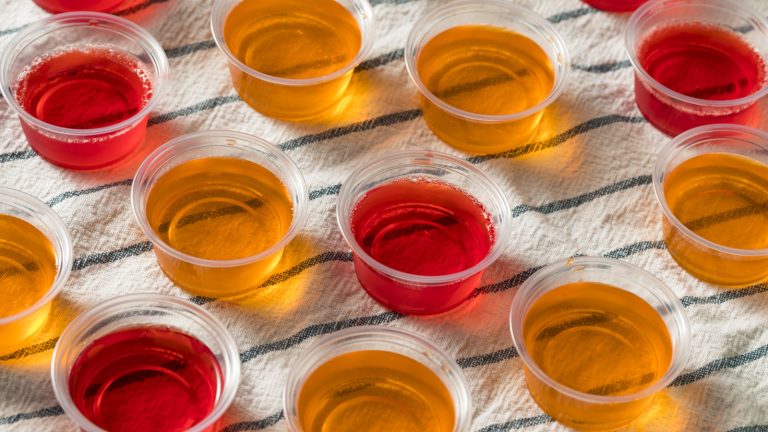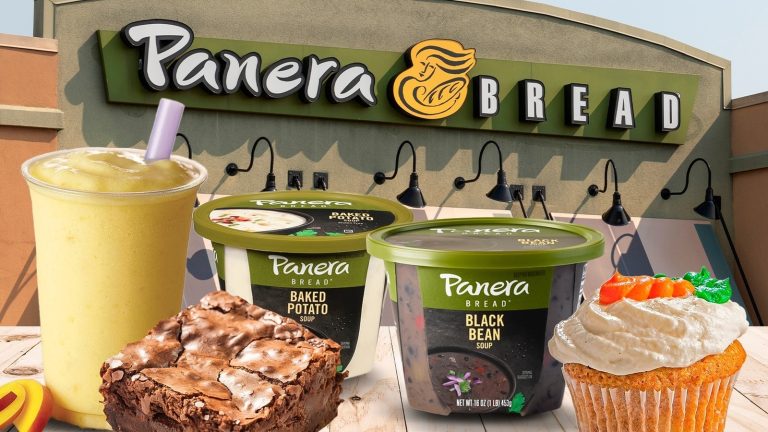Before strapping on an apron to determine whose cowboy casserole wins out among two viral internet recipes, let’s quickly untangle what qualifies as a casserole and what makes up its components. Though the exact origins of the hearty, one-dish meal appear hard to wrangle, the concept of homey, hot dishes that include cans of soup like the King Ranch casserole or become a Thanksgiving staple like the green bean casserole dates back to the 18th century. The cowboy casserole’s legacy is thought to date back to the American West’s chuckwagon era, when long-haul cowboys needed meals simple enough to cook over a campfire but were also full of sustenance for their grueling days on the frontier.
A casserole variety containing ground beef, cream of mushroom soup, shredded cheese, veggies, and either frozen tater tots or store-bought biscuits saw a resurgence in popularity last year among online foodies. As variations to the canon of cowboy casseroles swelled from a few scattered internet recipes to pages worth of options, the filling, approachable, and affordable casserole continues to capture the interest of online cooks.
Both Kent Rollins and Ree Drummond (aka The Pioneer Woman) tossed their hats into the ring, penning variations of the dish. Published less than three months apart, both creations marry melted cheese, ground beef, corn, onion, and mushroom soup, though subtle differences between their cowboy casseroles set the two Americana-oriented chefs apart. To decide which one we’ll save among our recipes moving forward, we whipped up both cowboy casseroles simultaneously to compare them.
Who are The Pioneer Woman and Kent Rollins?
Both Kent Rollins and The Pioneer Woman circulate online recipes inspired by old-timey, Western dishes and cooking styles. While Rollins describes himself as a chuckwagon cook offering authentic cowboy cooking and Ree Drummond, the voice behind The Pioneer Woman, refers to her cooking style as cowboy friendly, there is a lot of overlap between the two quasi-celebrity chefs.
Both Rollins and Drummond are accustomed to Food Network’s gaze; Rollins has appeared on “Throwdown! With Bobby Flay,” “Chopped Redemption,” and “Cutthroat Kitchen” while Drummond has enjoyed the spotlight with her own Food Network show since 2011. Though both chefs update their blogs several times a week, Drummond’s widespread success and busy schedule have afforded her enough bandwidth to employ a small staff, including Erin Merhar, The Pioneer Woman’s current food director and author of the website’s cowboy casserole rendition.
Drummond describes herself as a city girl turned domestic country wife and lives on a working cattle ranch. Rollins worked on cattle ranches for years before he started cooking for cowboys and expanded into catering. With the help of his wife, Shannon, they launched the Cowboy Kent Rollins YouTube channel, which has more than 3.27 million followers. Rollins’ website hawks his cookbooks, sauces, seasonings, and apparel, whereas The Pioneer Woman’s website offers an impressive display of dining sets, appliances, and other various home goods. Each prairie-oriented chef’s online recipe box contains similar, approachable, American-folk driven recipes, like the cowboy casserole.
Key differences with the cowboy casseroles
The most obvious difference between the competing cowboy casseroles lies in the ingredients each chef/blogger chose to top their casseroles before letting the oven take over. The Pioneer Woman blog entry relies on the somewhat standard crown of frozen tater tots, whereas Kent Rollins’ recipe covers the casserole’s contents with store-bought, refrigerated biscuits. Other online recipes call for boxed biscuit or cornbread mixture instead, but in essence, the casserole requires a crunchy, starchy lid for the meat-filled dinner.
The other immediately noticeable disparity between cowboy casseroles is the amount of meat each recipe asks for; while The Pioneer Woman’s recipe contains a pound of ground beef and four slices of bacon, Rollins’ recipe doubles the amount of ground beef and omits the pork product. Also, The Pioneer Woman’s casserole wisely includes a couple of green elements (baby spinach and chives) along with the customary corn, cream of mushroom soup, and garlic cloves. In comparison, Rollins’ recipe calls for canned corn and canned soup along with seasoning salt and garlic powder to add flavor; he also swaps The Pioneer Woman’s request for milk with the more decadent sour cream.
Which recipe is more expensive?
The cowboy casserole recipes from The Pioneer Woman and Kent Rollins are built to feed a hungry crowd; both aim to stretch a dollar past its ordinary value. Neither asks shoppers to spend over $40 on the list of required ingredients, although if you choose to splurge on higher quality cheese, milk, sour cream, and/or meat, you could find yourself with a pricier haul in your shopping cart.
At the end of the day, the price of each recipe more or less comes out in the wash. The Pioneer Woman makes up the price of the extra ground beef that Rollins’ version asks for by including extra pops of color and flavor. Where Rollins requires double the ground beef, The Pioneer Woman uses bacon, spinach, parmesan, and fresh garlic. However, if you believe in the adage “time is money,” you’ll have 25 minutes of cook time with Rollins’ cowboy casserole, which spends only half an hour from preparation to fully cooked, as opposed to The Pioneer Woman’s recipe, where you’ll spend nearly an hour (55 minutes) of total time in the kitchen.
Which recipe is easier?
Determining which recipe proved easier to make feels a little like blind tasting 7-Up and Sprite; while I nominally preferred putting together one recipe, I’m sure as many home cooks would point to the other as far as ease. Though The Pioneer Woman’s rendition of cowboy casserole asks its audience for a couple of minor additional steps like cooking bacon and chopping garlic and spinach, I would much rather tediously line tater tots over my mixture than attempt to smooth sour cream around the warm interior of a casserole as Kent Rollins instructs.
Again, though not difficult or ultimately crucial, evenly applying sour cream over the hot surface of cooked meat and canned soup proved more frustrating than anything. Furthermore, his lack of specifying if or when to remove the cast iron skillet from under the heat also caused a pause, as both the cheese and sour cream threatened to melt as I built the shallow stack of ingredients. Similarly, the recipe doesn’t specify an exact or suggested amount of seasoning salt to mix with the ground beef, so I found myself second-guessing my work. The Pioneer Woman’s more detail-oriented recipe guided me more expertly on how to cook this variety of casserole for the first time.
Which cowboy casserole looks better?
Again, The Pioneer Woman wins out, but this time (for my taste) more substantially. Though I harbor a guilty pleasure for the quick hack of (literally) popping open a can of Pilsbury biscuits, I side-eyed their place in the recipe upon first glance. Call it an allegiance to the beauty of tater tots, but the tiny morsels also visually break up the dish and add a more eye-catching element to a single-pan dish.
Admittedly, the biscuit-topped recipe from Cowboy Kent Rollins comes with a built-in serving suggestion as each biscuit hints at where one should scoop the gooey mixture onto a plate; however, the flat bread also appears less dynamic and even drab. Despite the dish being layered to more truly encapsulate the essence of a casserole, once spooned onto a plate, the effort holds zero effect on the end product. Finally, The Pioneer Woman’s inclusion of spinach throughout the casserole’s interior coupled with the chopped chives adhering to the top layer of tater tots and melted cheese draws the eye in and breaks up the monotony of an otherwise entirely beige and brown dish. Even scooped into a bowl, The Pioneer Woman’s recipe delivers a presentation that feels more at the forefront of its concept and, though messy, still looks appealing.
Which cowboy casserole tastes better?
As suspected, The Pioneer Woman’s recipe edged out Kent Rollins’ version of the cowboy casserole, despite their comparable ingredients. Little touches lent The Pioneer Woman’s recipe a layer of dimension missing from Rollins’ approach. The addition of spinach, more than one type of cheese (cheddar and parmesan), fresh garlic, and bacon gave the recipe a jolt of buoyancy and palpable decadence, wherein Rollins’ version felt slight and overtly fatty by comparison. Even while layering the ingredients, I second-guessed the amount of beef and sour cream that Rollins’ recipe requested to complete the cowboy favorite.
Finally, though my oven was set at the correct temperature, it took over five minutes past Rollins’ predicted 15 minutes for the canned biscuits to bake entirely through. Though the biscuits were a clever idea, I suspect that lining the top of the casserole with pre-made biscuits results in the side facing the wet casserole resisting a proper bake time. When I first removed the cast iron skillet from the 350-degree Fahrenheit oven, the biscuits still had nearly half of their height to cook through. So, although the top half of each biscuit came out fully baked and flaky, it took an additional five minutes for the remainder of the bready treat to cook entirely, causing the very top of each biscuit to lose some of its airiness. And once entirely baked, the biscuit’s height detracted from the center of the casserole that Rollins’ recipe insists on layering, creating an off-kilter ratio of bread to soup mixture.
Verdict in the cowboy casserole competition
Though I entered this competition fairly agnostic and unfamiliar with ever eating a cowboy casserole, I now know to trust tater tot-topped hot dishes tenfold over others covered in biscuits. Not only was the cook time off, but the amount of biscuits I was forced to buy to complete the recipe also doesn’t fully make use of the biscuit rolls. No matter how I arranged the breakfast items over the mixture, I was left with at least three spare biscuits that I’m not sure will keep without their original airtight container until morning.
Though the intent of casseroles seeks to feed a table full of diners without breaking the bank, The Pioneer Woman manages to pull off this thrifty trick with nuance. With the touch of a seasoned home cook, the Food Network host’s cowboy casserole avoids the common pitfalls of most casserole dishes more generally, wherein Kent Rollins trips into them. Fit for a long-haul cowboy, Rollins’ recipe results in a denser, fatty, one-note final product that, while tasty in the moment, feels heavier and lacks levity. The Pioneer Woman’s reliance on the crunchy texture of the tots’ exterior invites eaters to continue consuming the comfort food without question.
Methodology
Though I have never before assembled a cowboy casserole, I’ve worked for several years as a recipe developer for food brands and consider myself a more than capable home chef. To judge each recipe, I based my short ranking on how the end dish tasted, how readable the instructions were, and whether I found any creativity in the chef’s approach. I had no prior experience with either recipe blogger before comparing their cowboy casserole recipes, besides a vague concept of who The Pioneer Woman was via the Food Network.
If any recipe called for the same ingredients (such as cheddar cheese, onion, or canned cream of mushroom soup), I purchased the same brand for fairness. I sampled each variation of the casserole after the suggested cooling time (when included), and once more warmed up to test whether either dish re-heated better than its competitor. Finally, though the pans were slightly differently shaped, I baked each casserole in a cast-iron skillet as directed since using the wrong kind of dish might ruin your casseroles. In terms of timing, I completed one casserole before moving on to complete the second dish.





